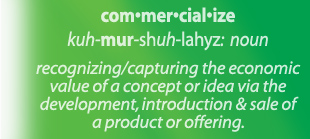Fusion Skills Development
Business Opportunity & Commerciazliation Assessment
Before the fruits of innovation become actionable in a commercial sense, one must first understand the scope, scale and quality of the opportunities presented by the successful development of that innovation. As an interdisciplinary program, Fusion student teams are given positioned to bring their own skills to bear on the question of value, while learning to apply the fundamentals of other disciplines to the same question. By blending a structured approach to the Legal, Business and Scientific criteria driving value, Fusion student team members produce and iteratively refine quantitive and qualitive analyses of a given invention, while learing the fundamentals that can ultimately drive commercial value.
In the above example, establishing a market size, general growth rate and basic (generalized) dynamics such as the Cost of Goods Sold, typical R&D investment rates and Sales and General Administration help to provide a very high level view of how much revenue an early market entrant might be able to generate (and share) over a period of years. Again, this approach is fundamentally generalized and provides only a high level financial opportunity that would exist for any entrant in the abstract.
Business Opportunity & Commercialization Assessment (BOCA) in a Nut Shell: From a business perspective, a reasonable up-front question is whether a given technology has the potential to generate profit. In order to ask this basic question, many important variables need to be normalized (or at least assumed to be favorable). This level of analysis is essentially:
MARKET SIZE: Examine the size of the market to make assess whether there is adequate overall revenue potential, demand and sustainable growth.
GENERAL MARKET ATTRIBUTES : To the extent anything can be determined at a high level about the industry and its players, describe pricing, operating and manufacturing costs, key competitors and known drivers.
As such, a BOA provides a fundamental litmus test for going forward – is there enough revenue potential here to proceed and do I understand the fundamentals of the market well enough to determine whether or not the technology and/or entrant in question is likely to succeed?
Contextualization – Taking BOCA to the next (logical) level
Beyond the general market opportunity assessment, a number of factors will closely guide not only the assessment of the quality of an opportunity, but will lead to the vectors around which a functional business plan can be crafted. With this early, fundamental work in place, an informed, nuanced decision can be made regarding not only the path(s) to success, but the potential for investment (by assigning value), strategic partnering and revenue sharing.
Identifying Specifics, Contextual Value Drivers and Hurdles
Even the above can be taken to a useful next step by further adding some specific, known projections (e.g., real operating, research& sales costs, etc.), as well as known hurdles that would naturally define product development and/or market entrance (e.g., regulatory requirements for biomedical technologies). With the beginning of this financial contextualization, the given business & technological opportunity begins to take closer shape, though it still lacks complete contextualization.
Deeper Contextual Factors
Early assessment non-market factors that can drive more informed value and strategic decisions include the following:
Intellectual Property: examining the prior art for potential freedom to operate. What potential claims exist? How crowded is the field? How much of the given technology might be embodied in patent claims? How much of those potential claims would be embodied in the potential product? How much dependency is there and how much would it cost?
Known or Potential Revenue Models: Who is the customer for the proposed product? Are there market intermediaries or established channels for delivery? Does the industry contain dynamics that limit or control pricing? Are there clear ways to improve upon the established model(s)?
Cost of Capital and Established Risk Parameters: Does this industry have established capitalization parameters? Is risk quantified across the industry (and/or within the stage of market entry under consideration)?
Capabilities: Does the proposed team have a particular (potentially “unfair”) advantage that might indicate a higher likelihood of success? Are the capabilities and relationship of the firm and its members sufficiently different from those of the competition to make them more successful?
Established pricing: Is pricing within the target industry and / or product sector static, understood or subject to change? Can the firm’s approach or capabilities somehow create new profit or competitive opportunities within current pricing dynamics?
Novelty of the Planned Value Proposition: Does the proposed product approach create, in the aggregate, a clearly higher value proposition than that of the competition?
Visibility into the Value Chain: Is the path to market sufficiently clear? Is it possible to connect with players in the existing or proposed value chain in ways that provide a competitive edge?
Fragmentation and Dominance: Is the market open to new entrants? Can a new entrant make and sustain a place for itself that will endure competition? Is current consolidation or fragmentation of the market an opportunity in and of itself?

